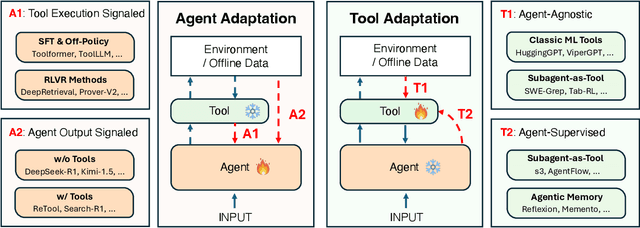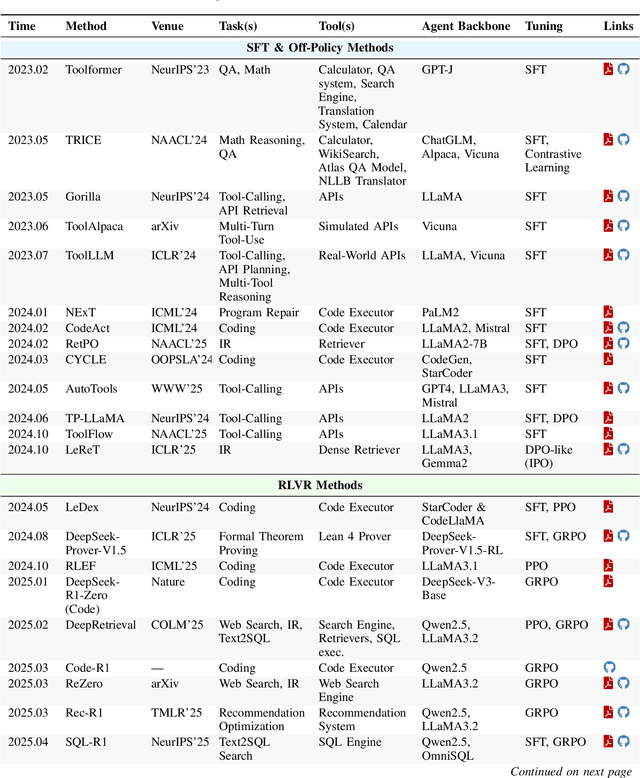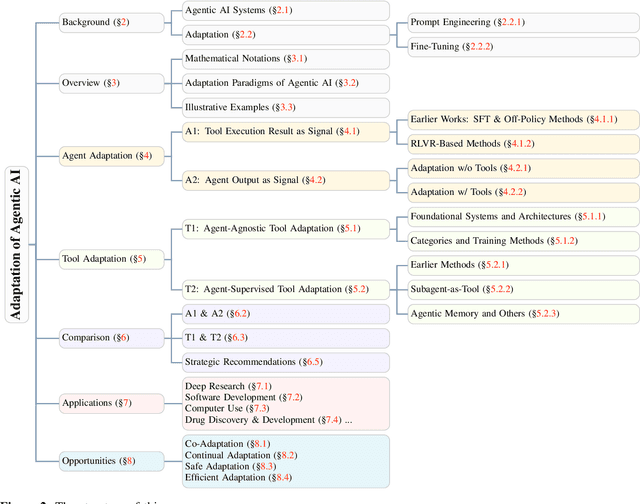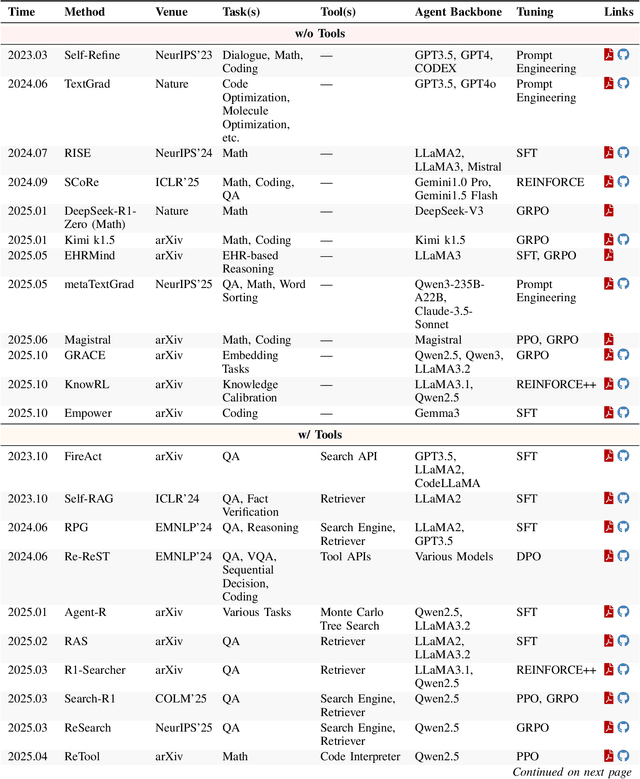Heng Wang
Step-DeepResearch Technical Report
Dec 24, 2025Abstract:As LLMs shift toward autonomous agents, Deep Research has emerged as a pivotal metric. However, existing academic benchmarks like BrowseComp often fail to meet real-world demands for open-ended research, which requires robust skills in intent recognition, long-horizon decision-making, and cross-source verification. To address this, we introduce Step-DeepResearch, a cost-effective, end-to-end agent. We propose a Data Synthesis Strategy Based on Atomic Capabilities to reinforce planning and report writing, combined with a progressive training path from agentic mid-training to SFT and RL. Enhanced by a Checklist-style Judger, this approach significantly improves robustness. Furthermore, to bridge the evaluation gap in the Chinese domain, we establish ADR-Bench for realistic deep research scenarios. Experimental results show that Step-DeepResearch (32B) scores 61.4% on Scale AI Research Rubrics. On ADR-Bench, it significantly outperforms comparable models and rivals SOTA closed-source models like OpenAI and Gemini DeepResearch. These findings prove that refined training enables medium-sized models to achieve expert-level capabilities at industry-leading cost-efficiency.
Adaptation of Agentic AI
Dec 22, 2025



Abstract:Cutting-edge agentic AI systems are built on foundation models that can be adapted to plan, reason, and interact with external tools to perform increasingly complex and specialized tasks. As these systems grow in capability and scope, adaptation becomes a central mechanism for improving performance, reliability, and generalization. In this paper, we unify the rapidly expanding research landscape into a systematic framework that spans both agent adaptations and tool adaptations. We further decompose these into tool-execution-signaled and agent-output-signaled forms of agent adaptation, as well as agent-agnostic and agent-supervised forms of tool adaptation. We demonstrate that this framework helps clarify the design space of adaptation strategies in agentic AI, makes their trade-offs explicit, and provides practical guidance for selecting or switching among strategies during system design. We then review the representative approaches in each category, analyze their strengths and limitations, and highlight key open challenges and future opportunities. Overall, this paper aims to offer a conceptual foundation and practical roadmap for researchers and practitioners seeking to build more capable, efficient, and reliable agentic AI systems.
PIGEON: VLM-Driven Object Navigation via Points of Interest Selection
Nov 17, 2025



Abstract:Navigating to a specified object in an unknown environment is a fundamental yet challenging capability of embodied intelligence. However, current methods struggle to balance decision frequency with intelligence, resulting in decisions lacking foresight or discontinuous actions. In this work, we propose PIGEON: Point of Interest Guided Exploration for Object Navigation with VLM, maintaining a lightweight and semantically aligned snapshot memory during exploration as semantic input for the exploration strategy. We use a large Visual-Language Model (VLM), named PIGEON-VL, to select Points of Interest (PoI) formed during exploration and then employ a lower-level planner for action output, increasing the decision frequency. Additionally, this PoI-based decision-making enables the generation of Reinforcement Learning with Verifiable Reward (RLVR) data suitable for simulators. Experiments on classic object navigation benchmarks demonstrate that our zero-shot transfer method achieves state-of-the-art performance, while RLVR further enhances the model's semantic guidance capabilities, enabling deep reasoning during real-time navigation.
Dual-Mode Magnetic Continuum Robot for Targeted Drug Delivery
Oct 02, 2025Abstract:Magnetic continuum robots (MCRs) enable minimally invasive navigation through tortuous anatomical channels, yet axially magnetized designs have largely been limited to bending-only motion. To expand deformation capabilities, this paper presents a simple assembly that embeds permanent magnets radially within the catheter wall, allowing a single externally steered permanent magnet to independently induce either bending or torsion. A physics-based formulation together with finite-element analysis establishes the actuation principles, and benchtop experiments validate decoupled mode control under practical fields. Building on this, a dual-layer blockage mechanism consisting of outer grooves and inner plates leverages torsional shear to achieve on-demand drug release. Finally, an in-phantom intervention experiment demonstrates end-to-end operation: lumen following by bending for target approach, followed by twist-activated release at the site. The resulting compact, cable-free platform combines versatile deformation with precise payload delivery, indicating strong potential for next-generation, site-specific therapies.
Continuously Steering LLMs Sensitivity to Contextual Knowledge with Proxy Models
Aug 28, 2025Abstract:In Large Language Models (LLMs) generation, there exist knowledge conflicts and scenarios where parametric knowledge contradicts knowledge provided in the context. Previous works studied tuning, decoding algorithms, or locating and editing context-aware neurons to adapt LLMs to be faithful to new contextual knowledge. However, they are usually inefficient or ineffective for large models, not workable for black-box models, or unable to continuously adjust LLMs' sensitivity to the knowledge provided in the context. To mitigate these problems, we propose CSKS (Continuously Steering Knowledge Sensitivity), a simple framework that can steer LLMs' sensitivity to contextual knowledge continuously at a lightweight cost. Specifically, we tune two small LMs (i.e. proxy models) and use the difference in their output distributions to shift the original distribution of an LLM without modifying the LLM weights. In the evaluation process, we not only design synthetic data and fine-grained metrics to measure models' sensitivity to contextual knowledge but also use a real conflict dataset to validate CSKS's practical efficacy. Extensive experiments demonstrate that our framework achieves continuous and precise control over LLMs' sensitivity to contextual knowledge, enabling both increased sensitivity and reduced sensitivity, thereby allowing LLMs to prioritize either contextual or parametric knowledge as needed flexibly. Our data and code are available at https://github.com/OliveJuiceLin/CSKS.
OpenCUA: Open Foundations for Computer-Use Agents
Aug 12, 2025Abstract:Vision-language models have demonstrated impressive capabilities as computer-use agents (CUAs) capable of automating diverse computer tasks. As their commercial potential grows, critical details of the most capable CUA systems remain closed. As these agents will increasingly mediate digital interactions and execute consequential decisions on our behalf, the research community needs access to open CUA frameworks to study their capabilities, limitations, and risks. To bridge this gap, we propose OpenCUA, a comprehensive open-source framework for scaling CUA data and foundation models. Our framework consists of: (1) an annotation infrastructure that seamlessly captures human computer-use demonstrations; (2) AgentNet, the first large-scale computer-use task dataset spanning 3 operating systems and 200+ applications and websites; (3) a scalable pipeline that transforms demonstrations into state-action pairs with reflective long Chain-of-Thought reasoning that sustain robust performance gains as data scales. Our end-to-end agent models demonstrate strong performance across CUA benchmarks. In particular, OpenCUA-32B achieves an average success rate of 34.8% on OSWorld-Verified, establishing a new state-of-the-art (SOTA) among open-source models and surpassing OpenAI CUA (GPT-4o). Further analysis confirms that our approach generalizes well across domains and benefits significantly from increased test-time computation. We release our annotation tool, datasets, code, and models to build open foundations for further CUA research.
DesignLab: Designing Slides Through Iterative Detection and Correction
Jul 23, 2025Abstract:Designing high-quality presentation slides can be challenging for non-experts due to the complexity involved in navigating various design choices. Numerous automated tools can suggest layouts and color schemes, yet often lack the ability to refine their own output, which is a key aspect in real-world workflows. We propose DesignLab, which separates the design process into two roles, the design reviewer, who identifies design-related issues, and the design contributor who corrects them. This decomposition enables an iterative loop where the reviewer continuously detects issues and the contributor corrects them, allowing a draft to be further polished with each iteration, reaching qualities that were unattainable. We fine-tune large language models for these roles and simulate intermediate drafts by introducing controlled perturbations, enabling the design reviewer learn design errors and the contributor learn how to fix them. Our experiments show that DesignLab outperforms existing design-generation methods, including a commercial tool, by embracing the iterative nature of designing which can result in polished, professional slides.
Step-Audio-AQAA: a Fully End-to-End Expressive Large Audio Language Model
Jun 10, 2025



Abstract:Large Audio-Language Models (LALMs) have significantly advanced intelligent human-computer interaction, yet their reliance on text-based outputs limits their ability to generate natural speech responses directly, hindering seamless audio interactions. To address this, we introduce Step-Audio-AQAA, a fully end-to-end LALM designed for Audio Query-Audio Answer (AQAA) tasks. The model integrates a dual-codebook audio tokenizer for linguistic and semantic feature extraction, a 130-billion-parameter backbone LLM and a neural vocoder for high-fidelity speech synthesis. Our post-training approach employs interleaved token-output of text and audio to enhance semantic coherence and combines Direct Preference Optimization (DPO) with model merge to improve performance. Evaluations on the StepEval-Audio-360 benchmark demonstrate that Step-Audio-AQAA excels especially in speech control, outperforming the state-of-art LALMs in key areas. This work contributes a promising solution for end-to-end LALMs and highlights the critical role of token-based vocoder in enhancing overall performance for AQAA tasks.
Unveiling the Hidden: Movie Genre and User Bias in Spoiler Detection
Apr 28, 2025Abstract:Spoilers in movie reviews are important on platforms like IMDb and Rotten Tomatoes, offering benefits and drawbacks. They can guide some viewers' choices but also affect those who prefer no plot details in advance, making effective spoiler detection essential. Existing spoiler detection methods mainly analyze review text, often overlooking the impact of movie genres and user bias, limiting their effectiveness. To address this, we analyze movie review data, finding genre-specific variations in spoiler rates and identifying that certain users are more likely to post spoilers. Based on these findings, we introduce a new spoiler detection framework called GUSD (The code is available at https://github.com/AI-explorer-123/GUSD) (Genre-aware and User-specific Spoiler Detection), which incorporates genre-specific data and user behavior bias. User bias is calculated through dynamic graph modeling of review history. Additionally, the R2GFormer module combines RetGAT (Retentive Graph Attention Network) for graph information and GenreFormer for genre-specific aggregation. The GMoE (Genre-Aware Mixture of Experts) model further assigns reviews to specialized experts based on genre. Extensive testing on benchmark datasets shows that GUSD achieves state-of-the-art results. This approach advances spoiler detection by addressing genre and user-specific patterns, enhancing user experience on movie review platforms.
Kimi-VL Technical Report
Apr 10, 2025



Abstract:We present Kimi-VL, an efficient open-source Mixture-of-Experts (MoE) vision-language model (VLM) that offers advanced multimodal reasoning, long-context understanding, and strong agent capabilities - all while activating only 2.8B parameters in its language decoder (Kimi-VL-A3B). Kimi-VL demonstrates strong performance across challenging domains: as a general-purpose VLM, Kimi-VL excels in multi-turn agent tasks (e.g., OSWorld), matching flagship models. Furthermore, it exhibits remarkable capabilities across diverse challenging vision language tasks, including college-level image and video comprehension, OCR, mathematical reasoning, and multi-image understanding. In comparative evaluations, it effectively competes with cutting-edge efficient VLMs such as GPT-4o-mini, Qwen2.5-VL-7B, and Gemma-3-12B-IT, while surpassing GPT-4o in several key domains. Kimi-VL also advances in processing long contexts and perceiving clearly. With a 128K extended context window, Kimi-VL can process diverse long inputs, achieving impressive scores of 64.5 on LongVideoBench and 35.1 on MMLongBench-Doc. Its native-resolution vision encoder, MoonViT, further allows it to see and understand ultra-high-resolution visual inputs, achieving 83.2 on InfoVQA and 34.5 on ScreenSpot-Pro, while maintaining lower computational cost for common tasks. Building upon Kimi-VL, we introduce an advanced long-thinking variant: Kimi-VL-Thinking. Developed through long chain-of-thought (CoT) supervised fine-tuning (SFT) and reinforcement learning (RL), this model exhibits strong long-horizon reasoning capabilities. It achieves scores of 61.7 on MMMU, 36.8 on MathVision, and 71.3 on MathVista while maintaining the compact 2.8B activated LLM parameters, setting a new standard for efficient multimodal thinking models. Code and models are publicly accessible at https://github.com/MoonshotAI/Kimi-VL.
 Add to Chrome
Add to Chrome Add to Firefox
Add to Firefox Add to Edge
Add to Edge